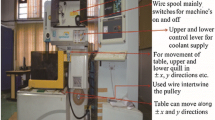Abstract
Obtaining the wire feed speed which can properly match the process parameters is difficult in double-wire-pulsed metal inert gas (MIG) welding. This work analyzed ten factors which affect the wire feed speed in reality and conducted corresponding correlation analysis. Then, four significant correlation factors, which were duty ratio, frequency, average current of leading wire, and average current of trailing wire, are selected as independent variables for establishing a double-wire feed speed prediction model. The model established by support vector machine regression used two evaluation criterions, which were the mean square error (MSE) and squared correlation coefficient (SCC), and then obtained the optimal model parameters by mesh optimization. Finally, the proposed model was validated by actual double-wire-pulsed welding experiments. This study can optimize the double-wire welding technological designing process and improve the intelligent double-wire welding industry.
Similar content being viewed by others
References
Liu A, Tang X, Lu F (2013) Arc profile characteristics of Al alloy in double-pulsed GMAW. Int J Adv Manuf Technol 65:1–7
Wei HL, Li H, Yang LJ, Gao Y, Ding XP (2014) Arc characteristics and metal transfer process of hybrid laser double GMA welding. Int J Adv Manuf Technol pp. 1–10 (online avialable)
Huang J, Fan J, Shi Y, Lu L, Shao L, Fan D (2011) Wire extension with dual freedom PID control in pulsed MIG welding process of aluminum alloy. In Mechanic Automation and Control Engineering (MACE), 2011 Second International Conference on Hohhot 15–17 July 2011, pp. 1876–1879
Nie J, Meng X (2011) Research on evaluation method of aluminum alloy pulse MIG welding stability base on approximate entropy. In 2011 3rd International Conference on Advanced Computer Control, Harbin 2011, pp. 12–15
Haidar J, Lowke JJ (1996) Predictions of metal droplet formation in arc welding. J Phys D Appl Phys 29:2951
Subramaniam S, White DR, Jones JE, Lyons DW (1999) Experimental approach to selection of pulsing parameters in pulsed GMAW. Weld J 78
Stanzel KA, Vogel BJ, Roehl C (2013) Welding wire feed speed control system method. US Patent
Toth TE (1976) Voltage sensor circuit for an arc welding wire feed control. US Patent
Palani PK, Murugan N (2006) Selection of parameters of pulsed current gas metal arc welding. J Mater Process Technol 172:1–10
Park HJ, Kim DC, Kang MJ (2008) Optimisation of the wire feed rate during pulse MIG welding of Al sheets. J Achiev Mater Manuf Eng 27:83–86
Palani PK, Murugan N (2007) Modeling and simulation of wire feed rate for steady current and pulsed current gas metal arc welding using 317L flux cored wire. Int J Manuf Technol 34:1111–1119
Rao ZH, Zhou J, Tsai HL (2012) Determination of equilibrium wire-feed-speeds for stable gas metal arc welding. Int J Heat Mass Transf 55:6651–6664
Tušek J (2000) Mathematical modeling of melting rate in twin-wire welding. J Mater Process Technol 100:250–256
Vapnik VN (1999) An overview of statistical learning theory. IEEETrans Neural Netw 10:988–999
Hong W-C, Pai P-F (2006) Predicting engine reliability by support vector machines. Int J Adv Manuf Technol 28:154–161
Salcedo-Sanza S, Ortiz-Garcı’aa EG, Pérez-Bellidoa ÁM, Portilla-Figuerasa A, Prietob L (2011) Short term wind speed prediction based on evolutionary support vector regression algorithms. Expert Syst Appl 38:4052–4057
Mountrakis G, Im J, Ogole C (2011) Support vector machines in remote sensing: a review. ISPRS J Photogramm Remote Sens 66:247–259
Wong P-K, Xu Q, Vong C-M, Wong H-C (2012) Rate-dependent hysteresis modeling and control of a Piezostage using online support vector machine and relevance vector machine. Ind Electron IEEE Trans 59:1988–2011
Mouraa MDC, Ziob E, Linsa ID, Droguetta E (2011) Failure and reliability prediction by support vector machines regression of time series data. Reliab Eng Syst Saf 96:1527–1534
Çaydaş U, Ekici S (2012) Support vector machines models for surface roughness prediction in CNC turning of AISI 304 austenitic stainless steel. J Intell Manuf 23:639–650
Shaoa Y, Lunetta RS (2012) Comparison of support vector machine, neural network, and CART algorithms for the land-cover classification using limited training data points. ISPRS J Photogramm Remote Sens 70:78–87
Pradhan B (2013) A comparative study on the predictive ability of the decision tree, support vector machine and neuro-fuzzy models in landslide susceptibility mapping using GIS. Comput Geosci 51:350–365
Yao P (2012) Intelligent control strategies and performance evaluation of integrated double wire arc welding power source. Doctor of Engineering, South China University of Technology, Guangzhou
Smola AJ, Schölkopf B (2014) A tutorial on support vector regression. Stat Comput 14:1999–222
Cherkassky V, Ma Y (2003) Comparison of model selection for regression. Neural Comput 15:1691–1714
Boser B, Guyon I, Vapnik V (1992) A training algorithm for optimal margin classifiers. In Proceedings of the 5th Annual ACM Workshop on Computational Learning Theory. ACM Press. pp. 144–152
Tian Y (2005) Applied research of support vector regression machine. Doctoral of Philosophy, China Agricultural University.
Kim K-j (2003) Financial time series forecasting using support vector machines. Neurocomputing 55:307–319
Tay FEH, Cao LJ (2001) Application of support vector machines in financial time series forecasting. Omega 29:309–317
Chapelle O, Vapnik V, Bousquet O, Mukherjee S (2002) Choosing kernel parameters for support vector machines. Mach Learn 46:131–159
Cherkassky V, Ma Y (2004) Practical selection of SVM parameters and noise estimation for SVM regression. Neural Netw 17:113–126
David FN, Pearson K (1985) Encyclopedia of statistical science. Wiley, New York
Freedman D, Pisani R, Purves (2007) Statistics. 4th ed. New York. W. W. Norton & Company
Scharf LL (1991) Statistical signal processing. 98
Fornell C, Larcker DF (1981) Evaluating structural equation models with unobservable variables and measurement error. J Mark Res 18:39–50
Liu J, Cai H, Tan Y (2007) Heuristic algorithm for tuning hyperparameters in support vector regression. J Syst Simul 19:1540–1543
Author information
Authors and Affiliations
Corresponding author
Rights and permissions
About this article
Cite this article
Yao, P., Xue, J. & Zhou, K. Study on the wire feed speed prediction of double-wire-pulsed MIG welding based on support vector machine regression. Int J Adv Manuf Technol 79, 2107–2116 (2015). https://doi.org/10.1007/s00170-015-7039-9
Received:
Accepted:
Published:
Issue Date:
DOI: https://doi.org/10.1007/s00170-015-7039-9




